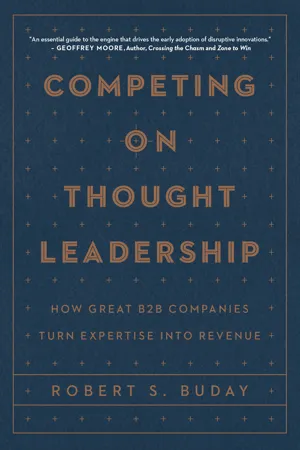
- English
- ePUB (mobile friendly)
- Available on iOS & Android
Competing on Thought Leadership
About This Book
"An essential guide to the engine that drives the early adoption of disruptive innovations."
-- Geoffrey Moore, Author, Crossing the Chasm and Zone to Win
HOW COMPANIES CAN VAULT AHEAD
BY DEVELOPING, MARKETING,
AND DELIVERING SUPERIOR EXPERTISE
"Thought leadership" is now a core part of the business lexicon. Numerous corporate websites devote whole sections to it. Entire conferences are built around it (TED and the World Economic Forum as the most exclusive ones). It's at the center of sophisticated, high-ticket PR campaigns. Thousands of people are making careers of it. And companies from Fidelity Investments, Adobe and Cigna to PwC, Accenture and Spotify have people in charge of it.
Interest in the field of thought leadership is white hot -- just like the buzz created by illustrious thought leaders when they bring groundbreaking ideas to market. So it's about time the topic of thought leadership itself got a substantive treatment.
In Competing on Thought Leadership, Robert Buday boldly delivers it. He defines thought leadership concretely: as the acclaim that a firm or a person earns for developing, marketing and delivering superior expertise in solving complex customer problems. And he defines it broadly -- as a business strategy, not just a marketing strategy.
Buday also brings to bear his client work and research since the 1980s in helping companies and individuals inside them become known worldwide as leading experts in their field, which in turn has increased their revenue and profit multifold.
This book focuses on how businesses that sell services and products to other businesses can thrive on thought leadership. It takes the lessons learned at some of the best firms in the world at selling expertise – consulting, accounting, law, financial services and technology firms – and makes them practical for every B2B firm.
Yet the principles of Competing on Thought Leadership apply to all organizations – for-profit and non-profit alike -- that must demonstrate superior expertise in solving complex problems. Consumer companies, charitable foundations and other organizations, too, can benefit greatly from adopting these best practices in thought leadership.
Frequently asked questions
Information
PART I
THE FORCES THAT HAVE BROUGHT THOUGHT LEADERSHIP TO THE FORE
CHAPTER 1
A MORE ENCOMPASSING DEFINITION OF THOUGHT LEADERSHIP

- 1. They focus their thought leadership resources on building deep and superior expertise on a small number of client problems. Of course, the bigger the firm, the greater the number of client problems it can focus on; the smaller the firm, the fewer. Deciding which client problems to focus on is at the core of an effective thought leadership strategy.
- 2. They create groundbreaking ideas about how to solve the client problems they’ve decided to “own.” A key way they create such ideas is by conducting primary research and collecting key lessons from their client projects. They create content that codifies the superior ways they solve client problems, based on this research and client experience. These activities are, in effect, their thought leadership research and development engine.
- 3. They turn their thought leadership R&D content into material that becomes a wellspring for marketing and sales campaigns: books, research reports, op-ed submissions, conference presentations, etc.
- 4. They also turn their thought leadership content into methodologies and internal training curricula. By doing so, they increase the number of people in their firms who can deliver this expertise to clients at a high level of quality.
THE 4 PILLARS OF THOUGHT LEADERSHIP

- • The explosion of books that use the phrase “thought leadership.”
- • The ascension of conferences designed purely to feature thought leaders, and only thought leaders.
- • The deluge of blog posts by both accomplished people and dilettantes opining on seemingly every topic under the sun.
- • The rise of B2B companies that aren’t in the publishing business to publish thought leadership periodicals.
- • The hundreds of thousands of people around the world with thought leadership in their job titles or job descriptions.
THE 21ST CENTURY THOUGHT LEADERSHIP GOLD RUSH
Table of contents
- Cover
- Praise for Competing on Thought Leadership
- Title Page
- Copyright Page
- Dedication
- Contents
- Prologue: Life at the Epicenter of a Blockbuster Concept
- Part I: The Forces That Have Brought Thought Leadership to the Fore
- Part II: Organizing and Steering Thought Leadership
- Part III: Creating Breakthrough Ideas
- Part IV: Attracting the Right Audience to Your Content
- Part V: Scaling Expertise
- Part VI: Turbocharging Thought Leadership
- Epilogue
- Acknowledgments
- Endnotes
- Index